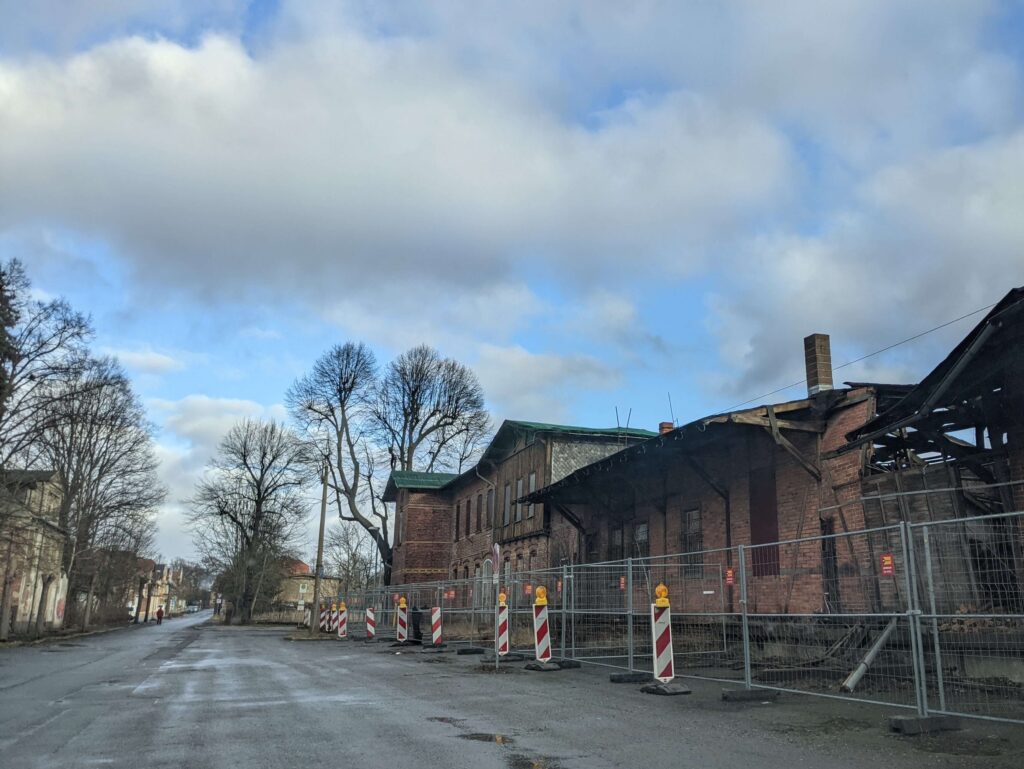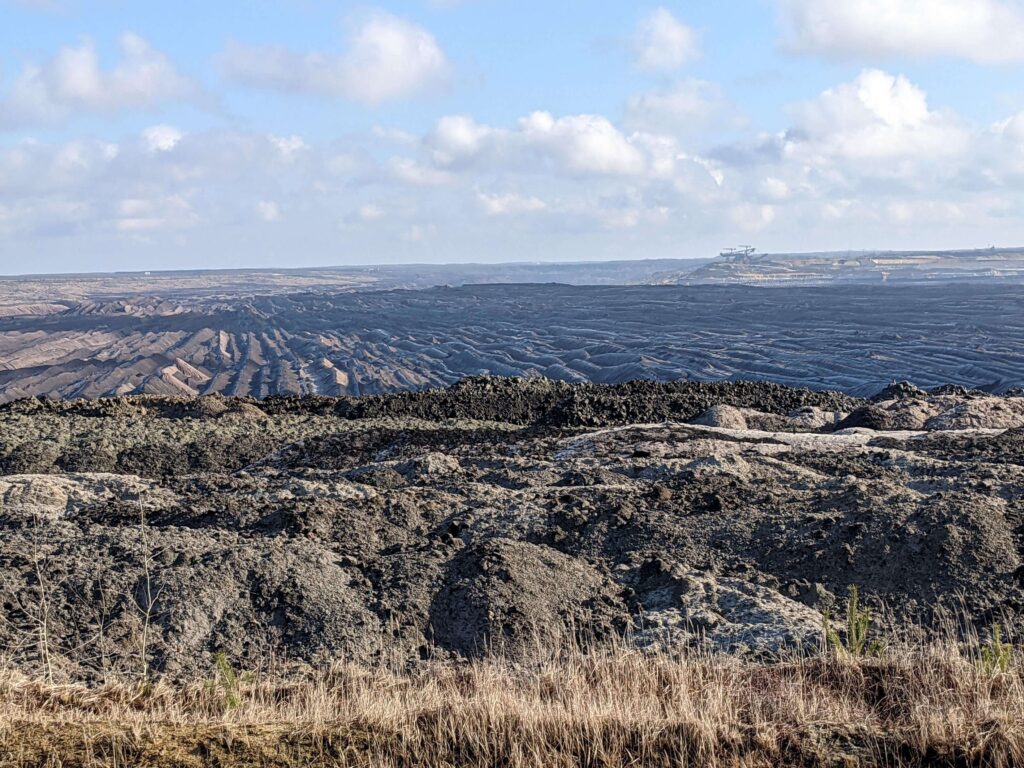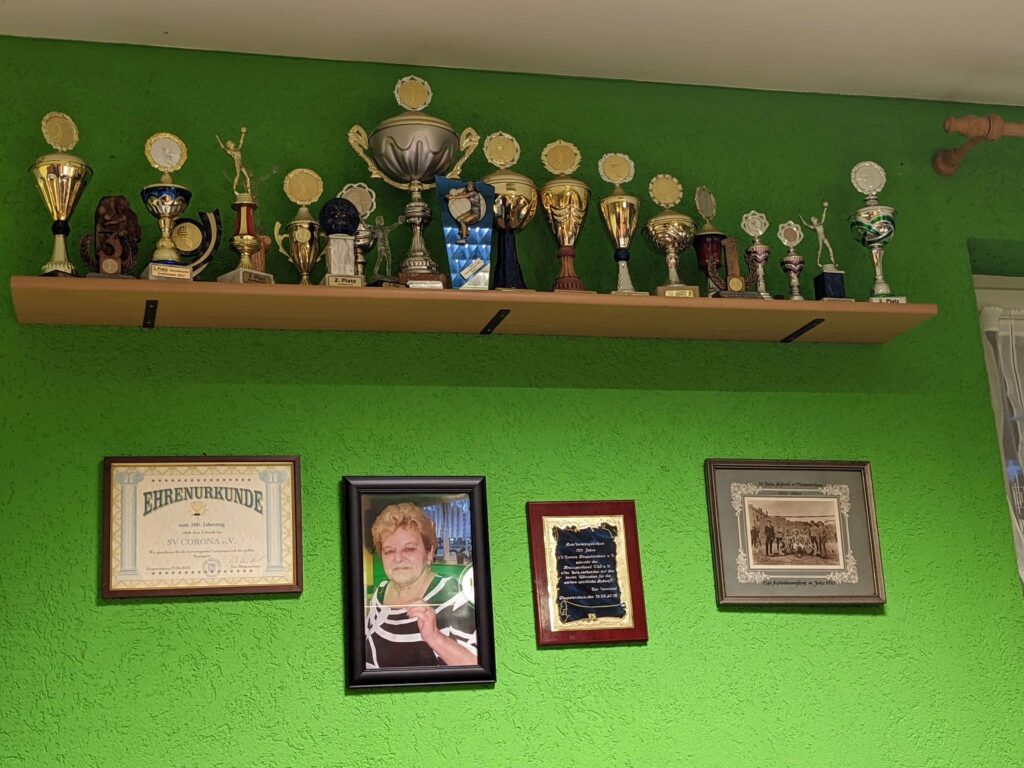The problem of social reproduction
DOI: 10.60650/emptiness-179t-zm06
In the coal mining regions of eastern Germany, the phenomenon of depopulation or emptying – by which the material and social relations which constitute a place change beyond recognition (Dzenovska 2020) – goes by two emic names: exsanguination and desertification. Exsanguination (Ausbluten) in German literally means the death of an organism through the total loss of blood. Desertification (Verwüstung) bears a double meaning: on the one hand, the word describes the process of aridification by which formerly fertile land turns into a desert; on the other hand, it can also signify the total destruction of land, places, or buildings to the point where they become uninhabitable. The two words, both rather dystopian in their teleological orientation, point to two interrelated processes of environmental and social degradation that characterise the period after 1989.
Exsanguination is used to describe the demographic changes in the aftermath of German reunification. The ‘loss of blood’ here pertains to the westward outmigration of about four million people in search of work and better lives in the early 1990s. After two years of euphoria about the GDR’s opening to democracy and capitalism, reunification came to mean deindustrialisation for many rural-industrial areas. In the early 1990s, the GDR’s state-owned enterprises were evaluated for their competitive potential on the capitalist market and reorganised into private companies under West German leadership. This led to mass closures, the rapid unmaking of the socio-corporate structures that had formerly organised everyday life, and the exodus of millions in search of work and opportunities.

After reunification, we were downright exsanguinated. Everything changed, virtually overnight: street names, job titles, political structures, bosses, neighbours...and all the closures! We didn’t know anyone who was able to keep their job. It was such a mess. And so many left. It took us a long time to reorientate, to cope with the new situation. We knew nothing, it was as if we had to relearn how to live! Sometimes we say that only the old ones and the stupid ones are left. It’s kind of true, we lack an entire generation of intelligent, skilful people in the East, of people who have ideas and visions. Everyone who had a little bit of money or connections left. And we still feel that today.
The group of rural-industrial towns and villages next to an opencast coal mine where I conducted fieldwork lost 6,000 of its 8,000 inhabitants. By 1994, the two local briquette factories, four glass foundries, and the drilling company were closed due to inefficiency and lack of developmental potential. With their closure, social life began to vanish as well: there were once four inns, eight pubs, three bakeries, one cinema, 38 shops, three fuel stations, and three train stations; now, one inn and one pub remain, the cinema is closed, and one fuel station and one train station are left. The 38 shops were replaced by two supermarkets. The last bakery closed in November 2021. Whereas before 1989, 17,000 additional people commuted into the town daily, now most of its inhabitants have become commuters themselves and drive up to 50 kilometres every day to reach their workplaces. At present, the mean age of the local population hovers around 58, and about a third is said to live on unemployment benefits.
When my interlocutors use the term ‘exsanguination’, however, it refers not only to the physical outmigration of their family members and neighbours. They also use it to describe the draining of energy that has overcome those who stayed behind. Many describe how they are watching their place fall apart as they go about their daily activities, and I have heard countless reports on how cumbersome life has become since 1989, as if everything one does is a burden, as if everything is a huge task one can barely push oneself to tackle. The total restructuring of political, economic, and social life after 1989 has had lasting effects on the local social fabric even as places are struggling to continue to exist in the new order.

The second local term for depopulation – ‘desertification’ – describes the erosion of the landscape through opencast mining, with its pervasive consequences of water shortage, soil degradation, pollution, and, crucially, village relocation practices and the ensuing social conflicts. My interlocutors have not only observed the drastic spatial changes around them since industrial coal mining began in the 1960s. They also came to experience the hazards of mining as direct assaults on their own bodies, homes, and ways of life. Groundwater has been lowered by more than 80 metres to protect the mine, which has also been drying out ponds, gardens, and fields.
In the entire region, about 30,000 people were relocated for expanding mines which often led to the dispersal or at least radical alteration of village structures and social relations (Pank 2022). In my field site, in addition to postsocialist exsanguination, mining-induced conflicts have thus further perforated the remaining social fabric. These conflicts created fault-lines within families, clubs, and political assemblies that have completely shaken up the established structures of local life, as people stopped talking altogether or turned to attacking and sabotaging one another wherever possible.
Sometimes I think we live more and more in a desert. I can’t imagine that after all this time of mining, of destruction, of exhausting both nature and people, that there is a way to recover. That there is still something to come after this. They have sucked everything out of the ground, out of us, too, in a way.... What’s left to work with? Look at the people, look at their faces, look at the town! If you ask about my perspective on the future, I can only think of desertification. It’s sad, but what can I say.
While exsanguination and desertification describe processes of depopulation, the people I encountered were not the ones who left but the ones who stayed. And for them, depopulation manifests not only in (physical) emptiness like abandoned buildings and closed shops, but to something even more pertinent to the making of a place: the loss of social energy in place. It is this theme that dominated my fieldwork conversations: the puzzlement about the fact that life in place does not ‘function’ anymore due to discontinued or disrupted energy flows among its people as their constellations and relationships were changed by ‘history’ and ‘politics’.

This, however, contrasts sharply with governmental approaches to ‘future-making’. For in contrast to regions which are ‘abandoned by the state’ (Gavrilova 2022), there has been renewed state interest in my fieldwork region in the form of ‘revitalisation’ campaigns. As coal mining has come under critique due to its immense environmental impact, Germany has decided to end coal mining by 2038, launching in 2019 a large-scale development programme of 40 billion euros to aid mining regions with transitioning into a post-coal future. Municipalities are now expected to design ‘future projects’ and submit them to the transformation agency of their federal state, which then channels the money provided by the federal government towards the local level. For eastern German places ravaged by the aforementioned processes of degradation, this sounded like a messianic promise of remedying the ‘scars of reunification’.
However, for places like my field site, participating in this sweep of change is easier said than done. Indebted municipalities find it hard to raise the equity ratio of 5-20% and lack people with the right kind of skills to write attractive grant applications. What is more, the types of projects that are accepted as ‘future-proof’ (zukunftsfähig) seem very distant from local realities. When my interlocutors look at the shiny transformation brochures and newspaper articles about ‘Lusatia as the new model region’, about the next wind and solar park, the next research centre, the next lakeside tourist attraction, they exclaim with a shake of the head:
What does this stuff have to do with us? The dimension that they completely forget about are the simple things that everyone needs for a normal life. It’s as if they jump straight to the stars and don’t understand that this doesn’t connect to anything locally. Who would come to work and live and go on holiday here if we don’t even have public transport, restaurants, shops, and cafés? Why can’t they start with normal things like renovating the school or restoring facades or making the bus connection more frequent? You can’t leave it as it is – I mean, you’ve seen the town – and sit and wait that people magically appear.

As the quote above demonstrates, many cannot understand why the most foundational things are not posited at the centre of future-making. Out of incomprehension and disappointment, many turn away from ‘future talk’ altogether in response. Even if there are ‘future workshops’ where locals are asked by young sociology students from faraway universities what their visions for the future would look like, these are poorly attended or cancelled altogether. Yet this behaviour does not constitute an example of stubborn ‘future-resistance’, ‘transformation fatigue’, or a principled rejection of change as is often pejoratively postulated in planning circles.
My interlocutors criticise that such polished future visions have nothing to do with local realities, visions that demonstrate disinterest in supporting the ways of the places they are purportedly concerned with. For it is in state-level transformation agencies and not in local contexts that the contours of creative and productive action for the future are debated and defined. What is more, locals sense that the ‘official futures’ are by definition designed in contradistinction to their own ways of life, that the future is to be invented in contrast to the traditional rural-industrial places which epitomise a past that needs to be overcome. Indeed, one of the most frequent views I heard in policy circles was: “You cannot really work with the locals; change has to come from outside if the transformation is to be successful”.
It is a dire situation where orientating themselves in the perforated present, let alone thinking about collective futures, poses an enormous challenge to my interlocutors. As a result, to many it seems like their town no longer has a place in the contemporary world. So, lingering between an eroded social order and an unrelatable future-making discourse, how do inhabitants of depopulated rural-industrial places situate themselves in a world that disapproves of them?
The answer is surprisingly simple. They turn to routines, to the things they have always done to maintain the ‘vessels’ of social energy even if its flows are faltering: organising small festivities, helping one another to repair things, managing what is left of their clubs, electing new leaders of the voluntary fire brigade, putting up photos to remember former heads of clubs when the activities were still lively and manifold – in short, making the place go on as well as they can, despite all the evidence of erosion and ruination around them.
Seen in this light, the reproductive action of community engagement is no less than life- and place-saving, even if the official future-making discourse tends to cast it off as not being creative or innovative enough. It is as if, through reproductive action, people say: “Look at us, we are still here, even though you do not want to see us!” Their non-participation in official future-making activities thus constitutes a silent critique against being relegated to the past because of – not despite – their efforts to sustain the place as they know it.

This is an Open Access article, distributed under the terms of the CC-BY (Creative Commons Attribution 4.0 International) licence, which permits unrestricted re-use, distribution, and reproduction in any medium, provided the original work is properly cited.
